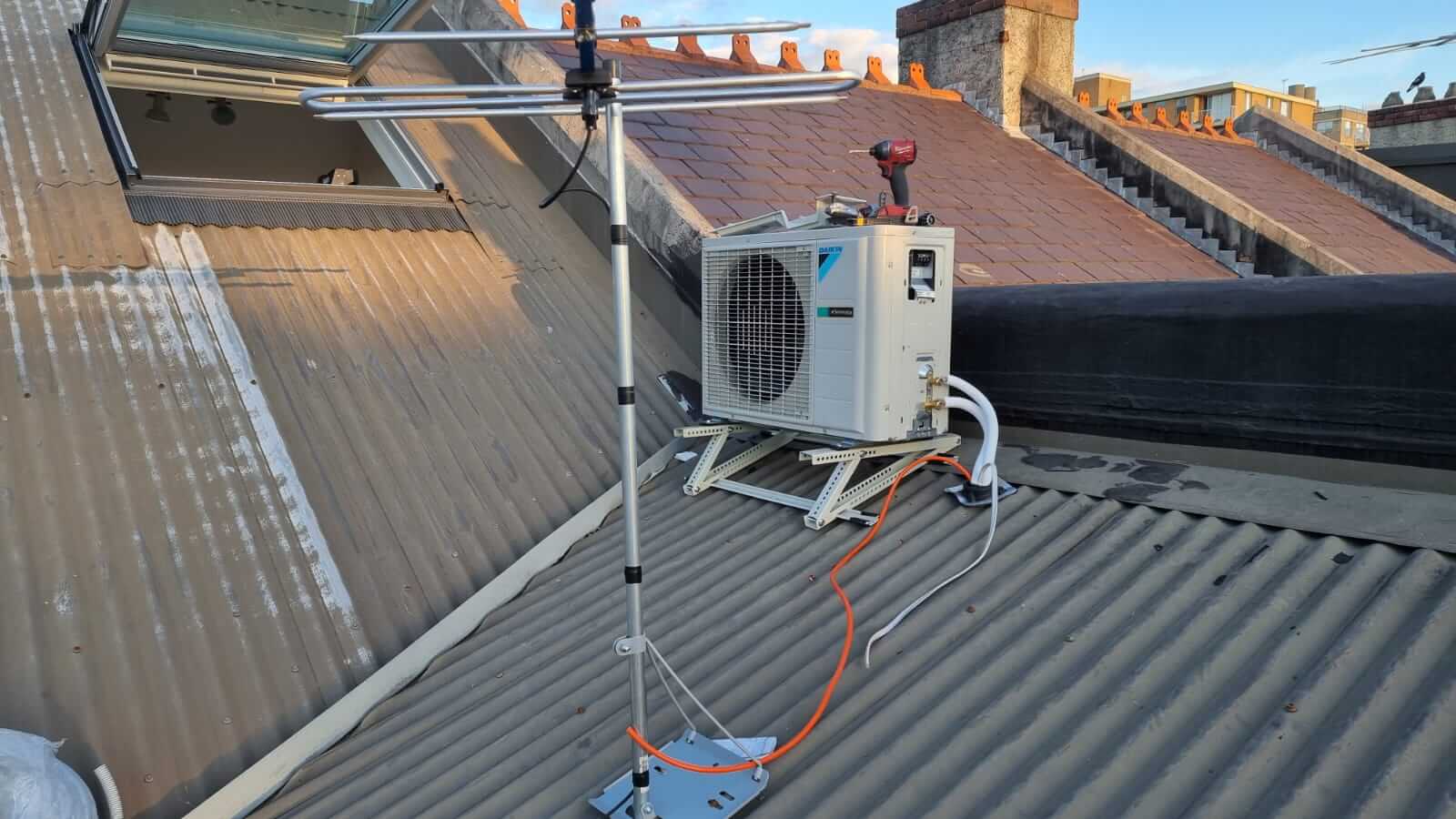
Let us remind you that most air conditioners do not provide an inflow of fresh air (oxygen), but only make sure that the room is kept at a constant temperature. Pros and Cons of such devices are obvious: on the one hand, a user can be sure that the room will be exactly the temperature he/she set at the conditioner. On the other hand, the risk of being in a stuffy (though comfortable in temperature) room increases. After all, a conditioner can work properly only when the windows are closed.
Let’s look at what kind of air conditioners there are and their differences.
Key Takeaways:
- Main types: window ACs, portable ACs, split systems, ducted systems, VRV/VRF multi-zone systems, central modular ACs, industrial ACs.
- Split and ducted systems most common for homes. Portable ACs good for rented spaces. Window ACs being phased out due to efficiency.
- Match cooling capacity in BTU/kW to room size. Rule of thumb is 100W per m2. Account for sun exposure, occupancy, ceiling height.
- Inverter ACs are more energy efficient, quieter, better temp control than conventional ACs.
- Consider noise rating (dB), control features (remote, thermostat, modes), energy rating (A+++, A++, A+), and extra functions (filters, sensors, etc).
- Installation factors include location of outdoor unit, ducting needs, window dimensions if applicable. Hire pros for complex installs.
- Leading brands: Daikin, Panasonic, Mitsubishi, Fujitsu, Samsung, LG. Prices range from budget to premium.
- Regular maintenance like cleaning coils, filters improves efficiency and lifespan. DIY basic tasks, leave complex repairs to professionals.
How to select the right air conditioning – Types of units
Domestic air conditioners could be divided into several of the most widespread types, differing by the method of installation and, of course, by dimensions. The main difference is whether our air conditioner has an external unit or not.
Air conditioners without an external unit include monoblocks (permanently installed in a suitable place, such as a window opening or a niche in the wall) and mobile (portable) air conditioners, which can be moved when necessary.
Portable air conditioning
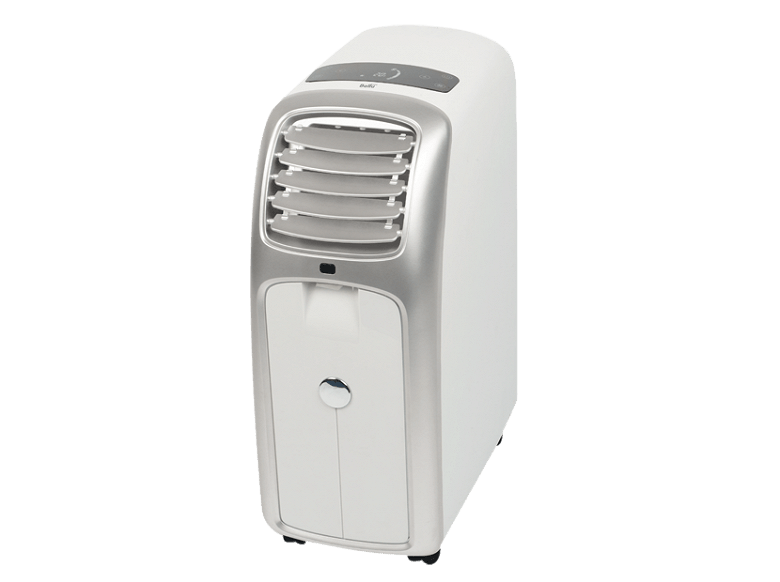
Portable air conditioners have a special pipe for the output of warm air, which must be mounted so that the air goes out the window (in the package with such devices you can often find an adapter for installation). As for condensate, in most cases it evaporates naturally, but in some cases you may need to remove it manually (drain the contents of the container).
Portable air conditioners are usually used when it is not possible or not reasonable to install a stationary air conditioner – at the cottage, in a rented apartment, etc.
Window air conditioning

Window air conditioner, which is installed directly in a window or in a special opening in the wall, is a separate kind of a monoblock. Just such conditioners were the most popular in the past, it is possible to say that with this construction the “boom of home air-conditioners” began (mainly in the USA). However, today they have considerably yielded their positions.
Window air conditioners can even be installed by yourself (if the window and / or room in principle allows the installation of such devices). But here is the main catch: with the appearance of double-glazed windows, installation of such conditioners must be calculated at the stage of measurements.
Well and if to take into consideration that window conditioners are predictably leading to the heat loss in winter time because of the low heat-insulation between “internal” and “external” halves of the device, it is evident that such devices can be seldom met at those places, where double-glazed windows are installed and much more often where wooden frames are used up till now.
Window air conditioners are notable for their compact size, easy mounting (and dismounting), and low price.
Split system air conditioning
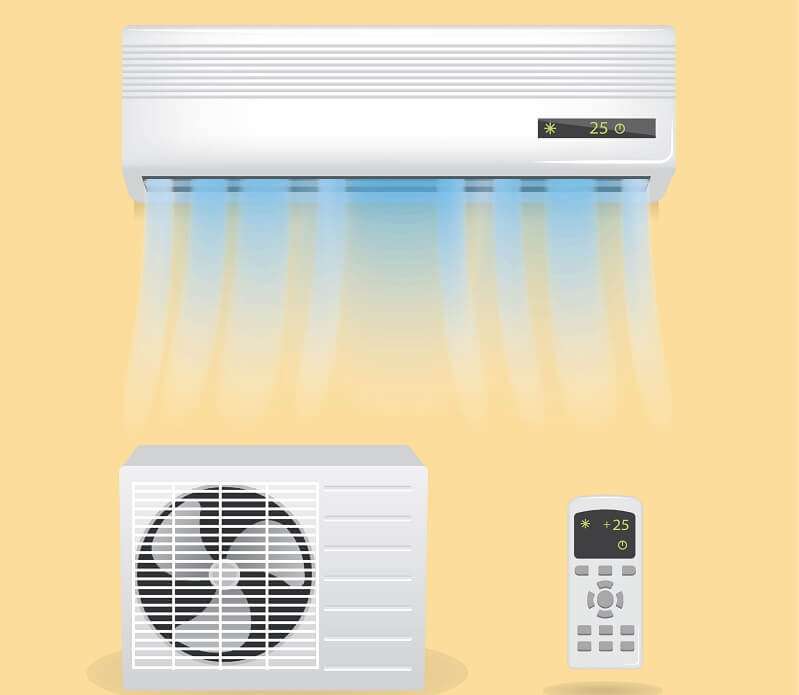
The next type is split-systems. They consist of two blocks, one of which is situated inside the apartment and the other is outside. Such a conditioner is often equipped with an air cleaning system, can work at heating and has a set of automatic modes. Both outer and inner blocks of such conditioners are familiar to everybody without exception.
There are several variants of split-systems, which differ according to their functionality and the way of installation. So, multi-split-systems consist of one outer block and several inner ones, which allows regulating independently the temperature level in each of the premises, where the inner block is installed (though all of them should work in one mode – either for heating or for cooling).
Ducted air conditioning

Ducted split system – designed specifically for concealed installation and implies the creation of a branched ventilation system (as a rule, it is placed above the suspended ceiling). Due to this, installation of one indoor unit can provide air regulation in several rooms at once (but in all of them the same temperature will be maintained). Such conditioners often have an option to add fresh air.
Finally, let us mention cassette conditioners. For installation of such a system, as well as for a channel conditioner, a false ceiling is needed. But unlike channel split-systems cassette-type conditioners distribute cooled air through the lower part of the block. The bottom part of the cassette split system has the size of a standard ceiling tile – 600×600 mm, and in case of high power it is twice as big – 1200×600 mm, and is closed by the decorative lattice with distributive jalousies.
Due to the distribution of air flows in four directions, this kind of split-system quickly and evenly cools or heats the air in a fairly large room (as a rule, such air conditioners are used in premises with an area of 50 square meters and more).
Industrial air conditioners

With all their advantages traditional split- and multi-split-systems are powerless when the question is about air-conditioning not in a private house or a small cafe, but at some large object. Certainly, it is possible to hang the walls of a shopping center with a hundred of outside units, but at first it is not aesthetically acceptable and secondly it is economically unprofitable.
There is a way out – industrial air-conditioner, which can reach 200-10000 kW. Such units are able to provide year-round comfort conditions for people in buildings of any area and number of floors and that is why they are successfully used at the most various objects:
- large office centers and public institutions,
- shopping and exhibition centers,
- hotels,
- medical facilities,
- catering establishments,
- theaters and concert halls,
- museums and libraries,
- indoor stadiums, swimming pools and sports complexes,
- pharmaceutical and other industrial facilities, etc.
One centralized installation serving the whole building is cheaper in the total amount as compared to split-systems in each room: increased expenses at the initial stage are compensated with the time reduced electric power consumption and economy on service and repair. Besides, industrial air-conditioners are installed in technical premises or on the roof and that means they don’t spoil the façade of the building and don’t disturb the workers and visitors with their noise.
The resource of industrial systems designed to control and maintain an optimal microclimate in large industrial and semi-industrial facilities is at least 20-30 years. The choice of the type and characteristics of the air conditioner is made taking into account the area of the building, its purpose and intensity of operation of the equipment.
Multizone VRV- and VRF-systems
Multizone VRV-system in its essence is an improved variant of the usual multi-split-system. But unlike the latter VRV allows connecting to one outdoor unit not several, but several tens of indoor units. Moreover the maximal distance between the indoor and the outdoor units is also increased: from now on it can be not 10-25 but 100 meters.
How was it possible to achieve such a dramatic change? If in usual multi-split-systems each indoor unit is connected to the outdoor unit with a separate freon line, in VRV-systems all units are connected to one pipeline consisting of two or three pipes. The refrigerant volume supplied from the common line to one or another indoor unit depends on the heat load of the unit and is controlled by an individual thermostatic regulating valve.
This technical solution allows to significantly reduce the loss of power of the air conditioner when adding another indoor unit or increasing the distance to it. In addition, installation works are faster and cheaper, and, more importantly, it is possible to easily upgrade the system, including its expansion, if necessary.
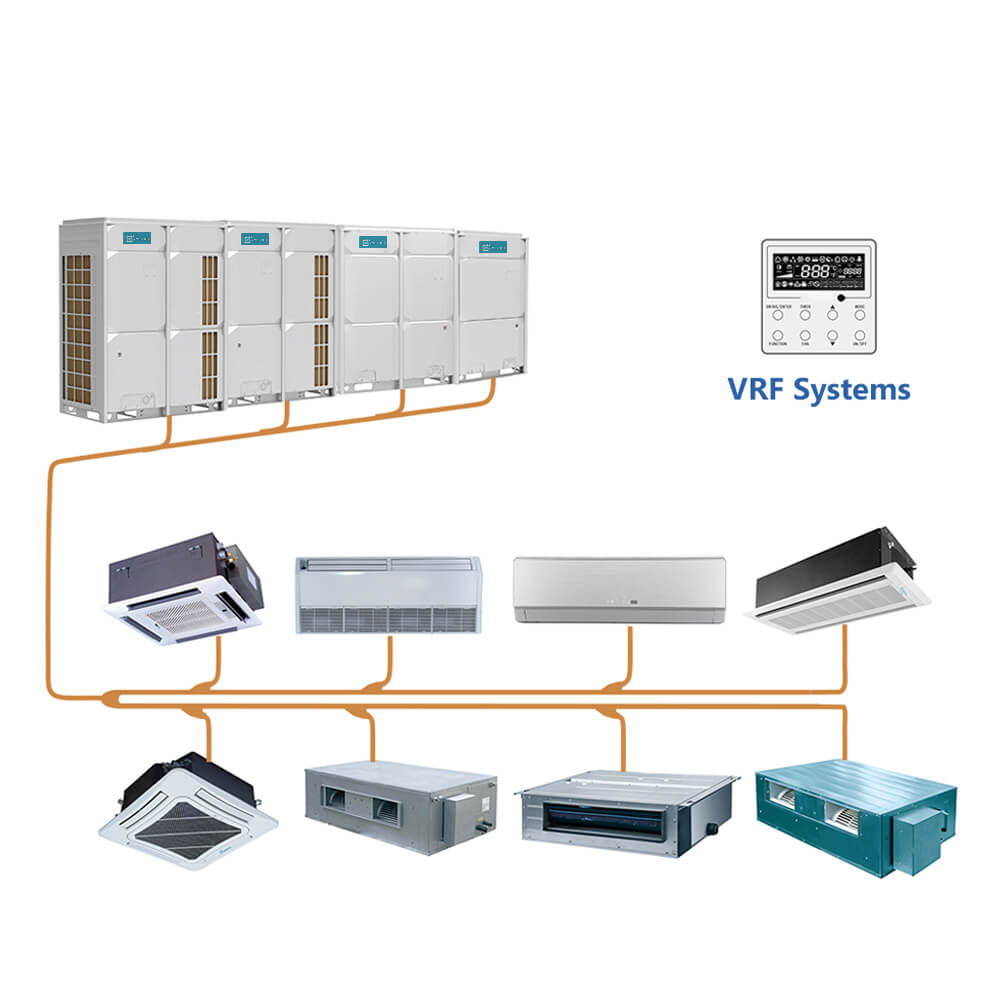
Like in usual multisystems the indoor units can be of different types and have different power (as a rule from 2 to 25 kilowatt). In this case each unit can be given its own mode, and they can be controlled either by individual remotes, or by a centralized remote control or personal computer.
Besides VRV- (Variable Refrigerant Volume) there are also VRF-systems (Variable Refrigerant Flow). In principle they do not differ from each other, the existence of different designations is due solely to the fact that VRV is a registered trademark Daikin, and therefore other manufacturers can not use this abbreviation.
Central air conditioners
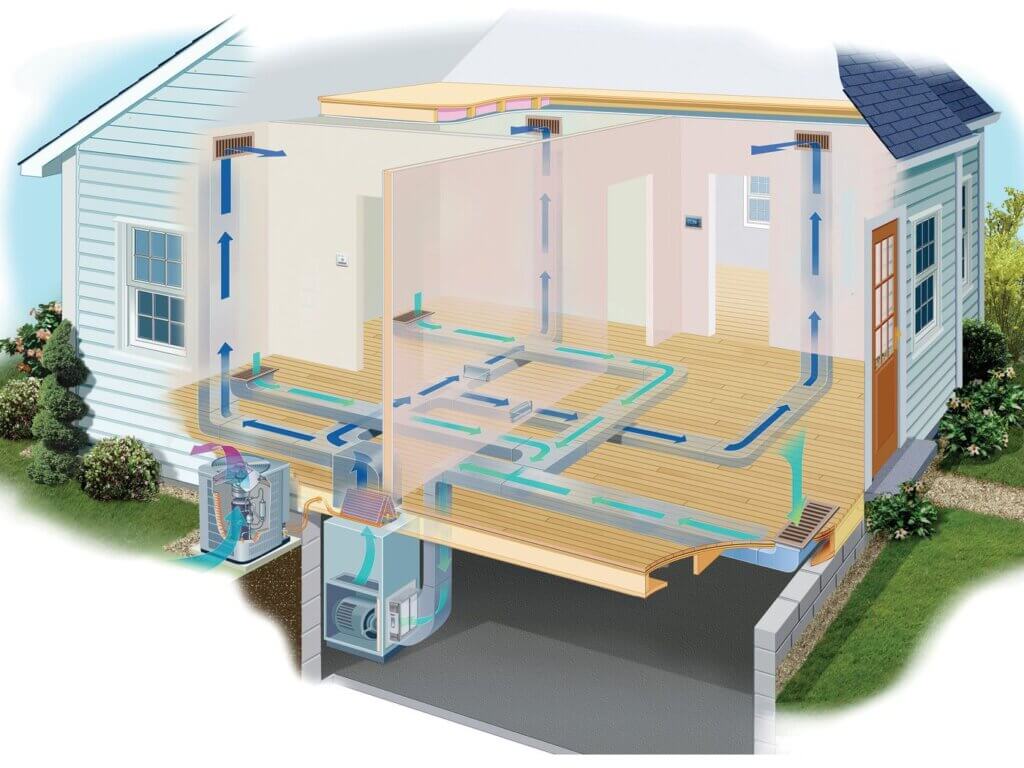
In principle the term central air conditioners can be applied to any industrial system. But it is also used for a special kind of air-conditioner – modular. Such conditioners are designed for solving the whole complex of problems – cooling or heating, humidifying or dehumidifying, ventilation and air cleaning.
Central air conditioners are made in the form of a set of standard modules, each of which is designed to perform a particular function:
- A cooling module is an external freon-powered compressor and condenser unit, or a chiller that cools water.
- The heating module can be one of two options. It can be either a water heater (heat exchanger connected to a central or autonomous heating system) or electric (a system of conventional heating elements).
- The ventilation module is designed to take in fresh air from the outside and supply it to the conditioned rooms. To reduce the noise created by the fan module, often additionally use a noise reduction system – a set of sound-absorbing plates of fiberglass or mineral wool.
- Humidification module includes a nozzle chamber or steam humidifier. If the air is humidified in the nozzle chamber, it is mandatory to install a droplet eliminator to prevent atomized water droplets from reaching other modules of the system.
- Filtration module is designed to clean the air supplied to air conditioned rooms from dust. With high requirements to the air quality two filtration modules are installed. One of them contains coarse filters (capable of trapping up to 60% of dust), the second one contains fine filters (capable of trapping up to 90% of dust).
Inverter and conventional air conditioners
Inverter air conditioner is equipped with a compressor with smooth regulation of the productivity, which is provided due to the frequency converter – inverter. Nowadays inverter air conditioners are available in the production line of every well-known manufacturer of climatic equipment.
Inverter air conditioners compare favorably with the smoothness of regulation, low noise level, energy efficiency and ability to work on heating. In that conditioners of inverter type are more difficult for installation and repair and are more expensive than usual, that is why you should choose them with care.
Power and size of the premise
In order to choose a proper conditioner, before leaving for a store, one should define the size of a room and find out its characteristics (the rooms, situated at the sunny side of the house, should have a stronger cooling system). Depending on this the capacity of the air conditioner is chosen.
There is an informal rule, according to which for one square meter of a premise one should have 100 W of capacity of a conditioner (in this case we are speaking about “cooling capacity”, but not about the consumed electric power). Thus, let us say that a conditioner with the cold-productivity of 2-2,5 KW will be able to maintain a comfortable temperature in a room with the area up to 20 square metres (of course if there are no additional sources of warmth).
In the instruction to each conditioner one indicates the space, for which area it is calculated, but very often the manufacturer overstates this parameter, that is why on the fact one has to buy conditioner with extra capacity or to study the reviews of the users, who have already tried the model, interesting for you in practice.
Also one should take into consideration that actually the conditioner cools not the area but the volume, that is why if your ceilings are much higher than 2,5-3 meters, the formula should be corrected.
Noise level
The noise level of the air conditioner is quite an important parameter. Especially if you intend to install an air conditioner in a living room or in a bedroom. Monoblock or portable conditioner will make more noise than a split system, as in this case the compressor is situated inside the premise, while in a split-system it is placed outside. Besides, in this case the additional noise is produced by the conditioner’s blowing system.
The maximal noise level of the air conditioner, as well as the power is pointed out in the instruction. But additional noise can arise from the appearance of undesirable vibrations and, in particular, can be transmitted to the floor (especially in case of wrong installation). In general, even in this case it will be worthwhile to read reviews of users: a large number of complaints about the noisiness of some models makes you think about the expediency of their purchase.
Control of air conditioner
The simplest way to control an air conditioner is a mechanical control panel, which allows switching on one of the modes.
For example, “fan+cold strong/fan+cold weak/fan strong/fan weak”. It is clear that with such a control panel it will not be too easy to set the most comfortable temperature in the room. And consequently you should think thoroughly before buying conditioner with such primitive control.
The overwhelming majority of models allow more precise settings, including precise temperature setting, timer, several power modes and so on. Almost all “serious” models are completed with a remote control. In our opinion, you should not save money in this case: it is better to get a device, which allows you to set the necessary mode precisely than to experiment with such conditioners, which can work in several modes that can be unsuitable for the climatic conditions of the premise.
The display on the indoor unit of the air conditioner allows you to know the current information about the temperature, humidity, selected mode, etc. It is not uncommon to have a display on the remote control, which is undoubtedly very convenient.
Air conditioning power consumption level
Like many other household appliances, air conditioners have energy efficiency classes. In the 2010s, according to the new EEC Directive, the highest class A was split into several subclasses: A+, A++ and A+++, allowing for the most accurate comparison of the energy consumption of different appliances. Calculation of these energy consumption classes is carried out by comparing a certain standard energy consumption with the actual one, which allows to refer the device to this or that class quite precisely and, thus, clearly show the buyer which device will allow to save on electricity and which will be more energy consuming.
Since the power of air conditioners can be very large, do not take the class of energy efficiency lightly: with regular use for several years more efficient devices can save a lot of money (which, of course, depends on the tariff on electricity in your area). The most energy efficient today is class A+++, which, however, is not very common, and appliances with this energy efficiency class will cost significantly more than their less economical counterparts.
Also we should mention that monoblocks and portable conditioners will be almost always less effective than split-systems.
Read about how to clean an air conditioner.
Additional features
A household air conditioner can have many additional functions and features that simplify the operation of the device, or increase the comfort of the user. Let’s list some of them.
Automatic temperature keeping. Conditioner with such function can automatically keep a set temperature, switching from one mode to another (cooling, heating and ventilation) or changing the speed of the fan and the direction of the air stream.
Auto restart. The auto restart function allows the unit to automatically return to the previous operating mode after a power failure or the end of the operating cycle.
Motion sensor. The motion sensor allows you to automatically switch the device to energy-saving mode when there is no motion in the room – for example, if the house is empty or at night when everyone is asleep. This can help prevent overcooling or overheating and save you money on your bills.
Air purification. Dust and photocatalytic air filters can be found in a standard air conditioner. In addition to these, some models are equipped with additional filters designed to kill bacteria and allergenic pollen. The residential series often has four filters (two dust and two photocatalytic), which together are very effective against all known sources of pollution. Well, the presence of a special deodorizing filter will rid the air in the room of unpleasant odors (such as pets or food) and tobacco smoke.
Night mode. After turning on this mode, the conditioner sets the minimal fan speed (for noise decrease) and smoothly decreases (while working on cooling) or increases (while working on heating) the temperature for 2-3 degrees during several hours.
Adjustment of air flow direction. Models with this feature are equipped with special guides that turn left-right and/or up-down to direct the airflow in the desired direction. This function, for example, prevents you from catching cold if your workplace or bed is located directly under the air conditioner.
Dehumidification Mode. This is an additional operating mode that removes excess moisture from the air. It can be useful in high humidity conditions (such as rainy weather).
Supply fresh air and humidify the air. In air conditioners with this functionality, the unit’s outdoor unit draws air from the street, cleans it and stores moisture, then delivers fresh air into the house in the desired volume. In addition, the air is humidified to the most comfortable level of humidity of 40%-60%.
Turbo mode. It allows you to reach the set temperature quickly. For this purpose the conditioner works at a high capacity, but not more than half an hour.
Wi-Fi support. Allows remote control of the air conditioner from a smartphone.
Conclusions
So, let us repeat the main rules of choosing an air conditioner for your home.
- The first thing you should decide with is a type of air conditioner: will it be a monoblock, a mobile conditioner or a split-system. For an apartment it makes sense to pay attention to wall-mounted split-systems. Such units are perfectly suitable for different climatic conditions and temperature fluctuations. And it makes sense to purchase mobile conditioners for country-side or for installation in rooms, where there is no possibility to install a split-system with an outer block. Cassette conditioners will be an excellent choice for premises from 50 m ² with a suspended ceiling. They are not used in smaller rooms.
- In the second place, you need to check whether the model you have chosen is suitable for your room. That is making sure that the power of the air conditioner is enough to keep the right temperature in a premise with a concrete area (it is better to check the instruction to the device).
- Thirdly, it is necessary to make sure that a control system of a conditioner satisfies your needs and allows you to adjust a required operating mode.
- Finally, before buying, you should check whether the device supports the functions that you really need, as well as clarify the service life of the filters.
When choosing a model of this or that model, you need to pay attention not only to the cooling area, but also to the energy efficiency of the system. You should not forget that air conditioners of class B and below will significantly increase your electricity bills.
Air Conditioning choosing FAQ
Q: How do I choose the right air conditioner?
A: Some of the things you’ll want to consider when choosing the right air conditioner include the size of the room, whether you’ll be cooling a single room or a full house, the type of unit you want, and how much space you have for installation.
Q: What size AC do I need for the calculator?
A: For the calculator, you can use an AC that’s pretty much any size. You just plug the information in and it does the work for you.
Q: What size room will a 1.7 KW air conditioner cool?
A: A 1.7kW AC will cool a room that’s 20m². This is perfect for rooms like a guest bedroom or even a home office.
